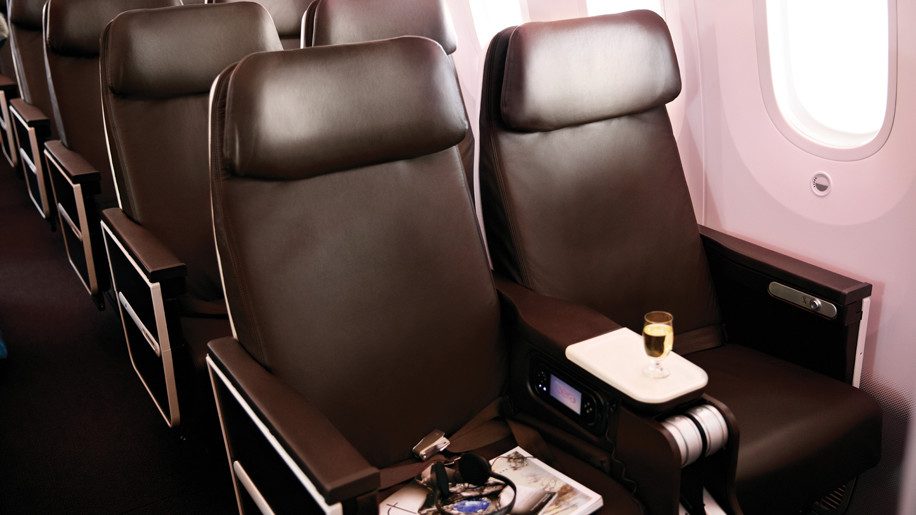
Virgin Atlantic’s new premium economy is being fast-tracked for a quick rollout across the entire fleet. The new seat is a further refinement of the premium economy cabin, which Virgin claims to have introduced in 1992 with its Mid Class product, though travellers may quibble that Eva Air and its Evergreen product was first. What’s certain is that Virgin has increased the number of premium economy seats on its aircraft and says that the £12 million revamp is in response to a 56 per cent increase in passengers flying in the cabin between 2005 and 2006, with some 500,000 passengers (out of a total of 4.8 million flying with the airline last year) flying in premium economy.
Virgin Atlantic’s chief operating officer, Lyell Strambi, said that the increase was due to passengers moving from both directions within the cabin towards premium economy seating. “Business customers are trading down looking for a better value proposition, while economy passengers are trading up. We’ve seen a considerable acceleration in the popularity of the product in the last three years and the new seats are a reaction to that.”
Strambi describes the typical Virgin Atlantic premium economy business travellers as falling into two groups: “The first are those in self-managed small businesses who want some comfort without the cost of Upper Class; the second are those working for large corporates who are allowed to fly in premium economy, but for whom a corporate travel policy wouldn’t stretch to the Upper Class product.”
The new seat has a 38-inch (97cm) seat pitch (the distance between the seat and the back of the seat in front – effectively legroom) and a width of 21 inches (53.3cm), making it wider than its competitors in the premium economy market. In part, this has been achieved by moving the control for the in-flight entertainment from the armrest to the back of the seat in front, underneath the TV screen. Virgin also claims that although the seat pitch has not increased from the previous version of the premium economy seat, there is more room with the new seat because of a thinner but more effective seat cushion.
Other features of the seat include its ergonomic S-shape; a dual-position footrest attached to the seat in front, which allows for an overall reduction in the weight of the seat – important for fuel economy; a new leather covering, which Virgin says is more comfortable, as well as easier to clean and reduces laundering (an important environmental benefit now that Virgin is focusing on global warming); and a redesigned tray table.
The headrest on the seat is adjustable in four ways, both up and down and with wings for sleep. Lastly, all seats have laptop power with power adaptors available free of charge from the cabin crew. This last feature is a considerable innovation when many airlines expect passengers to either have the full complement of adaptors with them in their laptop bags, or alternatively charge high prices by selling them on board.
Seat configuration differs depending on the aircraft flown, but on the lower deck of the Boeing 747 and all Airbus aircraft it is 2-3-2, and 2-2 on the upper deck of the 747. There are currently 58 premium economy seats on the aircraft operating out of Gatwick, and between 28 and 38 on the planes flying out of Heathrow.
Other benefits included in the price of the ticket include dedicated check-in, priority boarding and baggage reclaim, pre-departure drink and post-dinner liqueur, a redesigned meal service (crockery, metal cutlery), an upgraded amenity kit – though details of this are forthcoming and it is unlikely to be introduced before December 2006 – and a softer fleece blanket with a specially-designed neck, which apparently hugs the body more effectively and keeps passengers warm during flights. Throw in other details, like a fruit bowl available throughout the flight and Virgin believes it can succeed in gaining a further 10 per cent increase in premium economy passengers over the next five years in a worldwide market estimated at £500 million by chief executive Steve Ridgway.
The rollout of the new seats is a quick one, with all aircraft out of Heathrow having the seats by the end of next year, and flights from Gatwick shortly after that. The only puzzle remains why, given that the wildly successful top tier of Virgin’s three class offering is called Upper Class, the other two cabins can’t be brought into line as far as branding is concerned. Can we suggest the new premium economy ought to be termed Middle Class, and economy…. um, Lower…? Maybe not. We’ll leave the branding to the experts.
In-flight entertainment
The new cabins will have the V-Port, the third and most up-to-date of Virgin’s in-flight entertainment (IFE) systems. What it doesn’t have is internet access. Virgin Atlantic’s chief operating officer, Lyell Strambi, explained it had been rejected for a number of reasons.
“It adds a considerable amount of weight to the aircraft,” he told Business Traveller, “… and we were also not convinced how robust the signal would be, though that was a technical problem that would be overcome with time, I’m sure. More importantly, we weren’t convinced over the number of our passengers who would use the service. Our philosophy with the new V-Port IFE system has been to bring the entertainment to the passengers, rather than requiring the passengers to bring the hardware on board in the form of laptops.”
Instead, Strambi is pointing to new technology, such as the rollout of robust flexible keyboards with support from the IFE system, as a future solution, though the technology is at an early stage.








